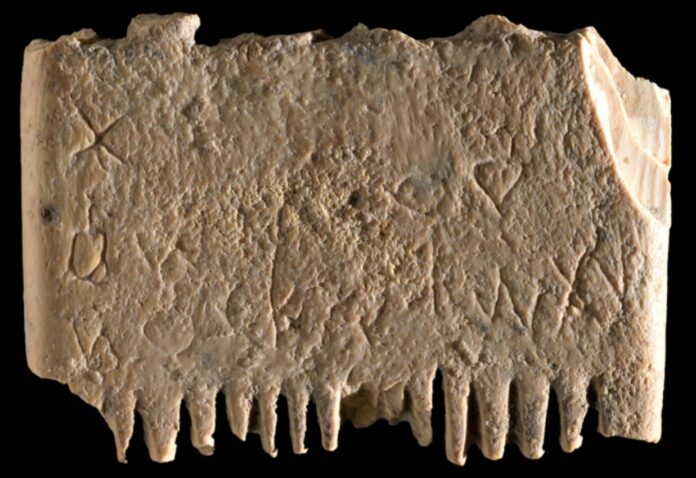The Canaanites, and later speakers of most other languages, adopted the alphabet shortly after its invention, approximately 1800 BCE. No significant Canaanite inscriptions, beyond a few isolated words, had been found in the Land of Israel until very recently. An incredible find now provides us with a complete sentence in Canaanite, written perhaps around 1700 BCE. A spell to ward off head lice is inscribed on a little comb made of ivory.
Hebrew University of Jerusalem (HU) and Southern Adventist University (USA) archaeologists Yosef Garfinkel, Michael Hasel, and Martin Klingbeil led the team that discovered the comb at Tel Lachish in Israel. Dr. Daniel Vainstub, a semitic epigraphist at Ben Gurion University, decoded the inscription. The ivory was authenticated as being from an elephant tusk by HU and BGU professors Rivka Rabinovich and Yuval Goren. Their research was published in the Jerusalem Journal of Archaeology.
The inscription’s letters were engraved quite roughly. Despite the fact that the site was unearthed in 2017, Dr. Madeleine Mumcuoglu didn’t notice the letters until 2022 during post-processing. Miriam Lavi took care of the cleaning and conservation.
The comb’s ivory teeth are about 3.5 by 2.5 cms in size. It’s a comb with teeth on both sides. The combs’ bases have survived, but the teeth were broken off long ago. There appears to be some erosion in the comb’s middle portion, presumably caused by the pressure of fingers holding the comb during haircare or the removal of lice from the head or beard. Like modern two-sided lice combs, the side with six heavy teeth was used to detangle knots in the hair, while the side with 14 fine teeth was used to remove lice and their eggs.
The Canaanite comb has 17 different symbols. They look ancient like they were made during the early days of the alphabet’s development. When put together, the seven letters create the Canaanite phrase, “May this tusk root out the lice of the hair and the beard.”
“This is the first sentence ever found,” as explained by Garfinkel, “in the Canaanite language in Israel. There are Canaanites in Ugarit in Syria, but they write in a different script, not the alphabet that is used till today.”
“The Canaanite cities are mentioned in Egyptian documents, the Amarna letters that were written in Akkadian, and in the Hebrew Bible. The comb inscription is direct evidence for the use of the alphabet in daily activities some 3700 years ago. This is a landmark in the history of the human ability to write,” added Garfinkel.
Combs in the past were typically crafted from natural materials like wood, bone, or ivory. Extremely rare and valuable, ivory was almost certainly an imported status symbol. Since there were no elephants in Canaan at the time, the comb most likely originated in neighboring Egypt, suggesting that even the wealthy were vulnerable to head lice.
The comb was examined for lice under a microscope, and images were taken of both sides. Lice eggs and larvae, measuring 0.5-0.6 mm, were discovered on the second tooth. However, due to Lachish’s climate, only the larva stage’s exterior chitin membrane could be preserved, not the entire louse.
The inscription on the Lachish comb may be modest, but it has some unique elements that help fill in gaps and lacunae in our understanding of the Bronze Age culture of Canaan. This is the earliest complete spoken sentence written in the Lachish Canaanite dialect, allowing for a thorough comparison of this language to its other sources. Second, the writing on the comb clarifies two previously undocumented facets of daily life at this period: haircare and the treatment of lice.
Third, unlike dedicatory and ownership inscriptions, this one really describes the object’s function, making it the first of its kind to be found in the region. Furthermore, the fact that the engraver was able to properly execute such small letters (1-3 mm wide) should now be taken into account in any attempt to summarize and make conclusions about literacy in Canaan in the Bronze Age.
During the second millennium BCE, the Canaanite city-state of Lachish was the most prominent city in the biblical kingdom of Judah, after Jerusalem. Lachish has the most Canaanite inscriptions (10) of any Israelite site discovered to date. Around 600 years, from around 1800 to 1150 BCE, the city served as the primary hub for the spread and preservation of the alphabet. Israel’s Nature and Parks Authority looks after the Tel Lachish site.
Source: 10.52486/01.00002.4
Image Credit: Dafna Gazit, Israel Antiquities Authority
